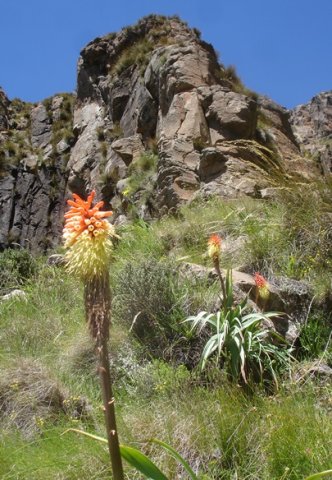Kniphofia

Author: Ivan Lätti
Photographer: Judd Kirkel Welwitch
Kniphofia is a genus of rhizomatous perennials in the Asphodelaceae or aloe family. The plants grow solitary or in clumps, the rhizomes thick and sometimes branched, the plants usually stemless. Plants grow around 2 m tall, rarely 4 m. The common name red-hot poker is used for several species, in Afrikaans vuurpyl (rocket).
The long narrow leaves are soft and V-shaped in cross-section, keeled and tapering slowly to acutely pointed tips. They mostly grow in basal rosettes, rarely distichous in a fan-shape. The leaf margins are smooth or minutely toothed.
The inflorescence is usually a simple spike or raceme, rarely branched, the many flowers densely or loosely arranged at the tip of a tall, erect stem. The dry and membranous bracts are longer than the short flower pedicels that are slightly bent or jointed. The flowers spread or droop, their tubes cylindrical or bell-shaped ending in short lobes. Flower colour is red in several shades, brown, yellow or white, while red buds often open turning yellow or white.
The stamens are often exserted when flowers open, sometimes retracting as they age. The superior, three-locular ovary is stemless with numerous ovules along its central axis. The thread-like style is exserted late, the stigma resembling a pinhead. Sunbirds and butterflies are among the pollinators of many South African species.
The fruit is a globose or ovoid capsule, often three-angled and papery when ripe. The seeds are flattened and three-angled or winged and fleshy.
There are about 70 Kniphofia species, mostly in Africa, also on Madagascar and Arabia with 48 in southern Africa. Some species feature in traditional medicine or charms related to for instance the prevention of lightning. Several species and some hybrids are popular garden plants.
The plant in picture is Kniphofia caulescens (Leistner, (Ed.), 2000); Vlok and Schutte-Vlok, 2015; Manning, 2009).

